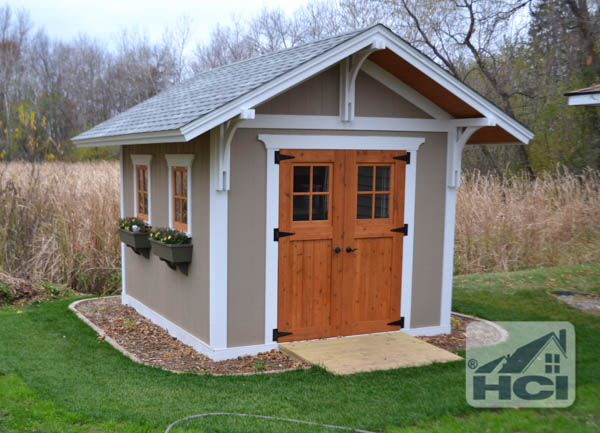Build A Shed Series Part 3| Build The Foundation


Build A Shed Series Part 3| Build The Foundation
In part 1 of the Build a Shed series we covered finding out what rules and codes apply in your community, finding a good plan, and getting a permit. In part 2 of the Build a Shed series we covered utility locating, materials ordering, and finally site preparation. In part 3 we’ll cover grading the site and building the foundation.
Marking the Shed Location
If you remember from part 2, we left off with just having cleaned and grubbed the site. If your lot is level then you can return the heavy equipment. If your lot is sloped like mine than keep the skid loader around for this step. Before you just start ripping into your lawn with the tractor it is important to locate the boundaries of where you want to build a shed and mark it with a string line where the stakes extend well past the ends of the excavation area. I set my string directly over the outside edge of where I wanted one of the 6×6 skids to go. The math for that is the offset from the property line to the outside wall of the shed plus the distance the skid is in from the wall.
Using a Laser Level
There are 4 components to a laser level setup, a laser, a tripod, a grade stick, and the receiver or target. If you don’t have a grade stick like the one pictured a straight 1×3 works very well.
The first step to using it is to set up the tripod a safe distance away from the work site that has line of sight to the whole work area and mount the laser to the top. Turn the laser on and then mount the receiver to the grade stick. If you’re trying to match grade to a known point, set the grade stick on that point and slide the receiver up and down until it has a solid tone and shows a horizontal line like the picture to the right. The laser is now set to the grade of the known point.
If you’re trying to determine the change in grade for the work area set the grade stick to the high point and adjust the receiver until it has a solid tone and has a horizontal line on the display. Next take the stick around the work site and suspend it in air until it tones solid and observe the distance from the bottom of the stick to the ground. This way you can see what the change in elevation is around the work area. If you’re looking to pick up a laser level for your own use, take a look at the Bosch GRL 500 HCK Rotary Laser we reviewed over at Tool Box Buzz.
Grade The Site
After running the laser around, I knew what areas need to be cut down and what areas needed to be filled in. I used the skid loader to shave off the dirt on the uphill side and push it towards the low end. If you don’t have a lot of equipment experience it can be hard to get it level with just the tractor. Have a garden rake and flat nose shovel handy to move the dirt around to get it closer to level using your eye. After moving the dirt around a bit and close to level, reset the receiver to the elevation of the bottom of the skid and check the area again. After it’s leveled, be sure to tamp and compact any soil that was disturbed.
*Note about fill – My site used to be a swamp that was filled in many years ago with sand and gravel. It makes for a great base for the shed but you may have to bring in a little sand or gravel under the skids.
Page: 1 2
Recent Posts
Framing Stick Nailer vs Coil Nailer
Which is Better a Stick Nailer or Coil Nailer? Framers have many choices in nailers…
How Many Roofing Nails Per Square of Shingles
Estimating How Many Nails for a New Roof When it comes to estimating materials for…
Composite / PVC Decking – Layout Tips & Advice
Composite / PVC Decking Layout Tips and Advice Composite and PVC decking have really changed…
Benefits of an ERV System (Energy Recovery Ventilator)
Benefits of ERV Systems (Energy Recovery Ventilator) If you're building a new home or doing…
Vermiculite Attic Insulation Abatement
Vermiculite Attic Insulation If your home was built before 1990 there is a chance it…
Nuisance Tripping of AFCI (Arc Fault) Circuit Breakers
Arc Fault (AFCI) Circuit Breakers Tripping Often An arc-fault circuit interrupter (AFCI) or arc-fault detection…

View Comments
Very nice looks great . best way to utilize your place